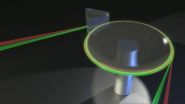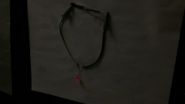(Press-News.org) University of Adelaide physics researchers have produced the world's most sensitive thermometer – three times more precise than the best thermometers in existence.
Published in the journal Physical Review Letters, the researchers from the University's Institute for Photonics and Advanced Sensing (IPAS) report they have been able to measure temperature with a precision of 30 billionths of a degree.
"We believe this is the best measurement ever made of temperature − at room temperature," says project leader Professor Andre Luiten, Chair of Experimental Physics in IPAS and the School of Chemistry and Physics, pointing out that it is possible to make more sensitive measurements of temperature in cryogenic environments (at very low temperatures) near absolute zero.
"We've been able to measure temperature differences to 30 billionths of a degree in one second," says Professor Luiten.
"To emphasise how precise this is, when we examine the temperature of an object we find that it is always fluctuating. We all knew that if you looked closely enough you find that all the atoms in any material are always jiggling about, but we actually see this unceasing fluctuation with our thermometer, showing that the microscopic world is always in motion."
The paper – Nano-Kelvin Thermometry and Temperature Control: Beyond the Thermal Noise Limit – describes a new and very sensitive, but unorthodox, thermometer that uses light to measure temperature. PhD candidate Wenle Weng carried out the work.
The thermometer injects two colours of light (red and green) into a highly polished crystalline disk. The two colours travel at slightly different speeds in the crystal, depending on the temperature of the crystal.
"When we heat up the crystal we find that the red light slows down by a tiny amount with respect to the green light," Professor Luiten says.
"By forcing the light to circulate thousands of times around the edge of this disk in the same way that sound concentrates and reinforces itself in a curve in a phenomena known as a "whispering gallery" – as seen in St Paul's Cathedral in London or the Whispering Wall at Barossa Reservoir – then we can measure this minuscule difference in speed with great precision."
Professor Luiten says the researchers have developed a new technique which could be redesigned for ultra-sensitive measurements of other things such as pressure, humidity, force or searching for a particular chemical.
"Being able to measure many different aspects of our environment with such a high degree of precision, using instruments small enough to carry around, has the capacity to revolutionise technologies used for a variety of industrial and medical applications where detection of trace amounts has great importance," Professor Luiten says.
INFORMATION:
The research is supported by the Australian Research Council and the South Australian Government's Premier's Science and Research Fund.
Media Contact:
Professor Andre Luiten
Professor of Experimental Physics
Institute for Photonics and Advanced Sensing
School of Chemistry and Physics
The University of Adelaide
Phone: +61 8 8313 2359
Mobile: +61(0) 404 817 168
andre.luiten@adelaide.edu.au
Robyn Mills
Media and Communications Officer
The University of Adelaide
Phone: +61 8 8313 6341
Mobile: +61 410 689 084
robyn.mills@adelaide.edu.au
World's best thermometer made from light
2014-06-02
ELSE PRESS RELEASES FROM THIS DATE:
Breakthrough in energy storage: Electrical cables that can store energy
2014-06-02
VIDEO:
Dr. Thomas and his team light an LED using energy stored in the outside coatings of an electrical cable.
Click here for more information.
Imagine being able to carry all the juice you needed to power your MP3 player, smartphone and electric car in the fabric of your jacket?
Sounds like science fiction, but it may become a reality thanks to breakthrough technology developed at a University of Central Florida research lab.
So far electrical cables are used only to transmit ...
Common cholesterol drug greatly alters inflammatory response to common cold
2014-06-02
Cold season may be just behind us, but a new discovery may shed light on how this common condition triggers asthma attacks. In a new research report published in the June 2014 issue of the Journal of Leukocyte Biology, researchers show that in individuals with asthma, statins significantly reduce the in vitro inflammatory response of human monocytes to rhinovirus (RV), the cause of the common cold. Not only does this discovery suggest that statins could help prevent or reduce the severity of asthma symptoms resulting from colds, but may also open the doors to further research ...
Why some experimental forms of 'The Pill for Males' will never rise to the occasion
2014-06-02
It appears that "The Pill" for men will have to wait a while longer. A new research report published in the June 2014 issue of The FASEB Journal involving mice, shows that a previously developed male hormonal oral contraceptive method (i.e. via testosterone) is unable to stop the production and / or the release of sperm.
"Our research in mice explains why the efficacy of male hormonal contraception is not as effective as expected and it provides clues on how to improve the method," said Ilpo Huhtaniemi, M.D., Ph.D., M.D.hc, FMed.Sci., a researcher involved in the work ...
Early steps toward personalized fitness: Interval training may benefit men more than women
2014-06-02
When it comes to reaping benefits of sprint interval training, it appears that men have won the battle of the sexes, if just barely. According to new research published in the June 2014 issue of The FASEB Journal, men create more new proteins as a result of this exercise than women do. The good news, however, is that men and women experienced similar increases in aerobic capacity. This study is the first to directly measure the creation of proteins made to adapt to this mode of exercise. The study also uniquely used methods that measure the cumulative making of proteins ...
Nano-platform ready: Scientists use DNA origami to create 2D structures
2014-06-02
Scientists at New York University and the University of Melbourne have developed a method using DNA origami to turn one-dimensional nano materials into two dimensions. Their breakthrough, published in the latest issue of the journal Nature Nanotechnology, offers the potential to enhance fiber optics and electronic devices by reducing their size and increasing their speed.
"We can now take linear nano-materials and direct how they are organized in two dimensions, using a DNA origami platform to create any number of shapes," explains NYU Chemistry Professor Nadrian Seeman, ...
Study finds that suicides are far more likely to occur after midnight
2014-06-02
DARIEN, IL – A new study provides novel evidence suggesting that suicides are far more likely to occur between midnight and 4 a.m. than during the daytime or evening.
Results show that the weighted, scaled mean suicide rate per hour was 10.27 percent after midnight, peaking at 16.27 percent between 2 a.m. and 2:59 a.m. In contrast, the mean suicide rate per hour was 2.13 percent between 6 a.m. and 11:59 p.m. When six-hour time blocks were examined, the observed frequency of suicide between midnight and 5:59 a.m. was 3.6 times higher than expected.
"This appears to ...
Antipsychotic medication during pregnancy does affect babies, study shows
2014-06-02
A seven-year study of women who take antipsychotic medication while pregnant, proves it can affect babies.
The observational study, published in the journal PLOS ONE, reveals that whilst most women gave birth to healthy babies, the use of mood stabilisers or higher doses of antipsychotics during pregnancy increased the need for special care after birth with 43 per cent of babies placed in a Special Care Nursery (SCN) or a Neonatal Intensive Care Unit (NICU), almost three times the national rate in Australia.
As well as an increased likelihood of the need for intensive ...
Neuron tells stem cells to grow new neurons
2014-06-02
DURHAM, N.C. -- Duke researchers have found a new type of neuron in the adult brain that is capable of telling stem cells to make more new neurons. Though the experiments are in their early stages, the finding opens the tantalizing possibility that the brain may be able to repair itself from within.
Neuroscientists have suspected for some time that the brain has some capacity to direct the manufacturing of new neurons, but it was difficult to determine where these instructions are coming from, explains Chay Kuo, M.D. Ph.D., an assistant professor of cell biology, neurobiology ...
Hypnosis extends restorative slow-wave sleep
2014-06-02
Sleeping well is a crucial factor contributing to our physical and mental restoration. SWS in particular has a positive impact for instance on memory and the functioning of the immune system. During periods of SWS, growth hormones are secreted, cell repair is promoted and the defence system is stimulated. If you feel sick or have had a hard working day, you often simply want to get some good, deep sleep. A wish that you can't influence through your own will – so the widely held preconception.
Sleep researchers from the Universities of Zurich and Fribourg now prove ...
Poor sleep equal to binge drinking, marijuana use in predicting academic problems
2014-06-02
DARIEN, IL – A new study shows that college students who are poor sleepers are much more likely to earn worse grades and withdraw from a course than healthy sleeping peers.
Results show that sleep timing and maintenance problems in college students are a strong predictor of academic problems even after controlling for other factors that contribute to academic success, such as clinical depression, feeling isolated, and diagnosis with a learning disability or chronic health issue. The study also found that sleep problems have about the same impact on grade point average ...


